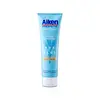What's inside
What's inside
 Key Ingredients
Key Ingredients

 Benefits
Benefits

 Concerns
Concerns

 Ingredients Side-by-side
Ingredients Side-by-side

Water
Skin ConditioningGlycerin
HumectantButylene Glycol
HumectantCocamidopropyl Betaine
CleansingSodium Myristoyl Glutamate
CleansingGlycol Distearate
EmollientSodium Cocoyl Glycinate
CleansingCitric Acid
BufferingCocamide Methyl Mea
Acrylates Copolymer
Sodium Chloride
MaskingPEG-14m
Emulsion StabilisingAlpha-Glucan Oligosaccharide
CleansingPolymnia Sonchifolia Root Juice
Skin ConditioningMaltodextrin
AbsorbentAspergillus Ferment
Skin ConditioningLactobacillus
Skin ConditioningPhenoxyethanol
PreservativeChlorphenesin
AntimicrobialWater, Glycerin, Butylene Glycol, Cocamidopropyl Betaine, Sodium Myristoyl Glutamate, Glycol Distearate, Sodium Cocoyl Glycinate, Citric Acid, Cocamide Methyl Mea, Acrylates Copolymer, Sodium Chloride, PEG-14m, Alpha-Glucan Oligosaccharide, Polymnia Sonchifolia Root Juice, Maltodextrin, Aspergillus Ferment, Lactobacillus, Phenoxyethanol, Chlorphenesin
Water
Skin ConditioningGlycerin
HumectantSodium Cocoyl Glycinate
CleansingLauryl Betaine
CleansingHydroxypropyl Starch Phosphate
Citric Acid
BufferingPEG-60 Glyceryl Isostearate
Sodium Chloride
MaskingGlyceryl Stearate Se
EmulsifyingCoco-Glucoside
CleansingPhenoxyethanol
PreservativeParfum
MaskingSodium Cocoyl Isethionate
CleansingSodium Phytate
Ethylhexylglycerin
Skin ConditioningPolyquaternium-7
Quillaja Saponaria Bark Extract
CleansingSodium Benzoate
MaskingCeramide NP
Skin ConditioningCeramide EOP
Skin ConditioningCeramide AP
Skin ConditioningCentella Asiatica Extract
CleansingNiacinamide
SmoothingCeramide As
Skin ConditioningPanthenol
Skin ConditioningCeramide Ns
Skin ConditioningSalicylic Acid
MaskingArginine
MaskingButylene Glycol
HumectantHydrogenated Lecithin
EmulsifyingCetearyl Alcohol
EmollientTocopherol
AntioxidantStearic Acid
CleansingHyaluronic Acid
HumectantAscorbic Acid
AntioxidantSodium Hyaluronate
HumectantCholesterol
EmollientPhytosphingosine
Skin ConditioningWater, Glycerin, Sodium Cocoyl Glycinate, Lauryl Betaine, Hydroxypropyl Starch Phosphate, Citric Acid, PEG-60 Glyceryl Isostearate, Sodium Chloride, Glyceryl Stearate Se, Coco-Glucoside, Phenoxyethanol, Parfum, Sodium Cocoyl Isethionate, Sodium Phytate, Ethylhexylglycerin, Polyquaternium-7, Quillaja Saponaria Bark Extract, Sodium Benzoate, Ceramide NP, Ceramide EOP, Ceramide AP, Centella Asiatica Extract, Niacinamide, Ceramide As, Panthenol, Ceramide Ns, Salicylic Acid, Arginine, Butylene Glycol, Hydrogenated Lecithin, Cetearyl Alcohol, Tocopherol, Stearic Acid, Hyaluronic Acid, Ascorbic Acid, Sodium Hyaluronate, Cholesterol, Phytosphingosine
 Reviews
Reviews

Ingredients Explained
These ingredients are found in both products.
Ingredients higher up in an ingredient list are typically present in a larger amount.
Butylene Glycol (or BG) is used within cosmetic products for a few different reasons:
Overall, Butylene Glycol is a safe and well-rounded ingredient that works well with other ingredients.
Though this ingredient works well with most skin types, some people with sensitive skin may experience a reaction such as allergic rashes, closed comedones, or itchiness.
Learn more about Butylene GlycolCitric Acid is an alpha hydroxy acid (AHA) naturally found in citrus fruits like oranges, lemons, and limes.
Like other AHAs, citric acid can exfoliate skin by breaking down the bonds that hold dead skin cells together. This helps reveal smoother and brighter skin underneath.
However, this exfoliating effect only happens at high concentrations (20%) which can be hard to find in cosmetic products.
Due to this, citric acid is usually included in small amounts as a pH adjuster. This helps keep products slightly more acidic and compatible with skin's natural pH.
In skincare formulas, citric acid can:
While it can provide some skin benefits, research shows lactic acid and glycolic acid are generally more effective and less irritating exfoliants.
Most citric acid used in skincare today is made by fermenting sugars (usually from molasses). This synthetic version is identical to the natural citrus form but easier to stabilize and use in formulations.
Read more about some other popular AHA's here:
Learn more about Citric AcidGlycerin is already naturally found in your skin. It helps moisturize and protect your skin.
A study from 2016 found glycerin to be more effective as a humectant than AHAs and hyaluronic acid.
As a humectant, it helps the skin stay hydrated by pulling moisture to your skin. The low molecular weight of glycerin allows it to pull moisture into the deeper layers of your skin.
Hydrated skin improves your skin barrier; Your skin barrier helps protect against irritants and bacteria.
Glycerin has also been found to have antimicrobial and antiviral properties. Due to these properties, glycerin is often used in wound and burn treatments.
In cosmetics, glycerin is usually derived from plants such as soybean or palm. However, it can also be sourced from animals, such as tallow or animal fat.
This ingredient is organic, colorless, odorless, and non-toxic.
Glycerin is the name for this ingredient in American English. British English uses Glycerol/Glycerine.
Learn more about GlycerinPhenoxyethanol is a preservative that has germicide, antimicrobial, and aromatic properties. Studies show that phenoxyethanol can prevent microbial growth. By itself, it has a scent that is similar to that of a rose.
It's often used in formulations along with Caprylyl Glycol to preserve the shelf life of products.
Chances are, you eat sodium chloride every day. Sodium Chloride is also known as table salt.
This ingredient has many purposes in skincare: thickener, emulsifier, and exfoliator.
You'll most likely find this ingredient in cleansers where it is used to create a gel-like texture. As an emulsifier, it also prevents ingredients from separating.
There is much debate on whether this ingredient is comedogenic. The short answer - comedogenic ratings don't tell the whole story. Learn more about comegodenic ratings here.
The concensus about this ingredient causing acne seems to be divided. Research is needed to understand if this ingredient does cause acne.
Scrubs may use salt as the primary exfoliating ingredient.
Learn more about Sodium ChlorideSodium Cocoyl Glycinate is a cleansing agent. It can be naturally derived or synthetically-created.
As a surfactant, it helps clean your skin by gathering dirt, oil, and other pollutants to be rinsed away more easily.
Water. It's the most common cosmetic ingredient of all. You'll usually see it at the top of ingredient lists, meaning that it makes up the largest part of the product.
So why is it so popular? Water most often acts as a solvent - this means that it helps dissolve other ingredients into the formulation.
You'll also recognize water as that liquid we all need to stay alive. If you see this, drink a glass of water. Stay hydrated!
Learn more about Water